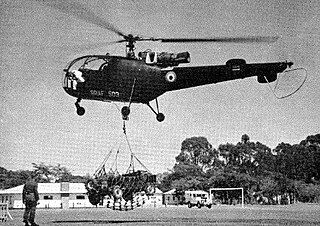
Rhodesia, officially from 1970 the Republic of Rhodesia, was an unrecognised state in Southern Africa from 1965 to 1979, equivalent in territory to modern Zimbabwe. Rhodesia was the de facto successor state to the British colony of Southern Rhodesia, which had been self-governing since achieving responsible government in 1923. A landlocked nation, Rhodesia was bordered by South Africa to the south, Bechuanaland to the southwest, Zambia to the northwest, and Mozambique to the east. From 1965 to 1979, Rhodesia was one of two independent states on the African continent governed by a white minority of European descent and culture, the other being South Africa.

The Malayan Emergency, also known as the Anti–British National Liberation War(1948–1960), was a guerrilla war fought in British Malaya between communist pro-independence fighters of the Malayan National Liberation Army (MNLA) and the military forces of the Federation of Malaya, British Empire and Commonwealth. The communists fought to win independence for Malaya from the British Empire and to establish a socialist economy, while the Malayan Federation and Commonwealth forces fought to combat communism and protect British economic and colonial interests. The term "Emergency" was used by the British to characterise the conflict because London-based insurers would not have paid out in instances of civil wars.
Operation Dingo was a major raid conducted by the Rhodesian Security Forces against the Zimbabwe African National Liberation Army (ZANLA) headquarters at Chimoio and a smaller camp at Tembue in Mozambique from 23 to 25 November 1977.

The Rhodesian Bush War, also called the Second Chimurenga as well as the Zimbabwe War of Independence, was a civil conflict from July 1964 to December 1979 in the unrecognised country of Rhodesia.

The Rhodesian Air Force (RhAF) was an air force based in Salisbury which represented several entities under various names between 1935 and 1980: originally serving the British self-governing colony of Southern Rhodesia, it was the air arm of the Federation of Rhodesia and Nyasaland between 1953 and 31 December 1963; of Southern Rhodesia once again from 1 January 1964; and of the unrecognised nation of Rhodesia following its Unilateral Declaration of Independence from Britain on 11 November 1965.

Air Marshal Norman Walsh was a senior officer in the Rhodesian Air Force and the first commander of the Air Force of Zimbabwe.

Air Rhodesia Flight 825 was a scheduled passenger flight that was shot down by the Zimbabwe People's Revolutionary Army (ZIPRA) on 3 September 1978, during the Rhodesian Bush War. The aircraft involved, a Vickers Viscount named the Hunyani, was flying the last leg of Air Rhodesia's regular scheduled service from Victoria Falls to the capital Salisbury, via the resort town of Kariba.

The 1st Battalion, The Rhodesian Light Infantry, commonly the Rhodesian Light Infantry, was originally formed in 1961 as a regiment of the army of the Federation of Rhodesia and Nyasaland. Raised as a light infantry unit at Brady Barracks, Bulawayo in Southern Rhodesia, the Regiment served in the Rhodesian Bush War as part of the Rhodesian Security Forces between 1964 and 1979, from 1965 under the unrecognised governments of Rhodesia and latterly, during the second half of 1979, Zimbabwe Rhodesia. The RLI remained active during an interim period under British control and then, from April 1980, within the armed forces of Zimbabwe, before disbanding on 31 October 1980.
Operation Uric was a cross-border raid carried out in Mozambique by operatives of the Rhodesian Security Forces during the Rhodesian Bush War, with combat assistance from the South African Air Force. During the operation, which took place from 1 to 7 September 1979, up to 200 Rhodesian and South African military personnel attacked bridges and a major staging point for Zimbabwe African National Liberation Army (ZANLA) insurgents in Gaza Province. Along with Operation Miracle, this was one of the largest Rhodesian external operations of the war.
The 1st Battalion, The Rhodesian Light Infantry, commonly the Rhodesian Light Infantry, served in the Rhodesian Bush War as part of the Rhodesian Security Forces between 1964 and 1979, under the unrecognised government of Rhodesia after its Unilateral Declaration of Independence from Britain on 11 November 1965. Latterly, during the second half of 1979, it fought for Zimbabwe Rhodesia, a reorganised version of Rhodesia under a black majority government which still went unrecognised. After an interim period under British control from December 1979 to April 1980, the RLI briefly remained active within the armed forces of the internationally recognised Republic of Zimbabwe, but did not see action under this government. It laid up its colours on 17 October 1980 and disbanded two weeks later.

Southern Rhodesia, then a self-governing colony of the United Kingdom, sent two military units to fight with the Commonwealth armed forces in the Malayan Emergency of 1948–60, which pitted the Commonwealth against the Malayan National Liberation Army (MNLA), the military arm of the Malayan Communist Party. For two years, starting in March 1951, white Southern Rhodesian volunteers made up "C" Squadron of the Special Air Service (SAS). The Rhodesian African Rifles, in which black rank-and-filers and warrant officers were led by white officers, then served in Malaya from 1956 to 1958.
The Battle of Chnihoyi, also known as the Battle of Sinoia was a small military engagement fought near Sinoia between a small unit of Zimbabwe African National Liberation Army (ZANLA) guerrillas and the Rhodesian police force on 28 April 1966. The skirmish is generally considered the opening engagement of the Second Chimurenga. A team of seven ZANLA cadres engaged with British South Africa Police forces near the northern town of Sinoia. The seven guerrillas all eventually died in the battle, the police killing all seven.
Operation Nickel or the Wankie Campaign or the Wankie Battles was a military operation launched by the Rhodesian Security Forces on 1 August 1967 in response to the group of ZIPRA and Umkhonto we Sizwe (MK) fighters crossing the Zambezi River, which marked the Rhodesian-Zambian border. The operation was a success with only one of the cadres out of a force of seventy-nine making it back to Zambia.
Operation Cauldron was launched by the Rhodesian Security Forces in response to an incursion by ZIPRA insurgents on 28 December 1967. Despite the death or capture of 77 out of 79 men, ZAPU, from its base in the Zambian capital, Lusaka, did not regard the incursion as a failure; on the contrary, its leaders were pleased that they had inflicted some casualties on the Rhodesian African Rifles. Buoyed by what they perceived as a success, they planned another operation to take place in northern Mashonaland: about 100 men—75 ZIPRA and 25 MK—were to infiltrate the Zambezi valley and establish a series of camps, including underground caches containing food, clothing, weapons and other equipment. They were instructed to avoid the Rhodesian Security Forces "at all cost" while they recruited local tribesmen to the nationalist cause and trained them. Once a sufficient indigenous force existed, they were to inform Lusaka, which would then coordinate a mass uprising. The aim was not to defeat the government forces, but rather to force the British military to intervene. If the operation were a success, the MK men were to be escorted to South Africa to begin similar activities.
Operation Gatling, which took place on 19 October 1978, was a joint-force operation into Zambia launched by the Air Force and Army of Rhodesia; the main forces which contributed were Rhodesian Special Air Service and Rhodesian Light Infantry paratroopers. Gatling's primary target, just 16 kilometres north-east of central Lusaka, Zambia's capital, was the formerly white-owned Westlands Farm, which had been transformed into ZIPRA's main headquarters and training base under the name "Freedom Camp". ZIPRA presumed that Rhodesia would never dare to attack a site so close to Lusaka. About 4,000 guerrillas underwent training at Freedom Camp, with senior ZIPRA staff also on site.

Operation Griffin was a military operation launched by the Rhodesian Security Forces, on 16 July 1968, in response to an incursion into Rhodesia by communist insurgents belonging to the ZIPRA based in Zambia.
Operation Panga was a military operation launched by the Rhodesian Security Forces (RSF) against a camp belonging to the communist insurgent group, ZIPRA. The cadres camp was located on the Mushenshi River in Zambia.
Operation Ignition was an operation undertaken by the Selous Scouts of the Rhodesian Army on 18 September 1976 against the forces of the guerrilla group ZIPRA Francistown.
Operation Chamber was a military raid launched by the Rhodesian Security Forces (RSF) against a camp belonging to the communist insurgent group, ZANLA. The cadres camp was located in Chinvinge, Tete Province, Mozambique. During the course of the operation three troopers were killed, Corporal P O Rice, Trooper C.F Lang and Lance Corporal E Nel were killed.









